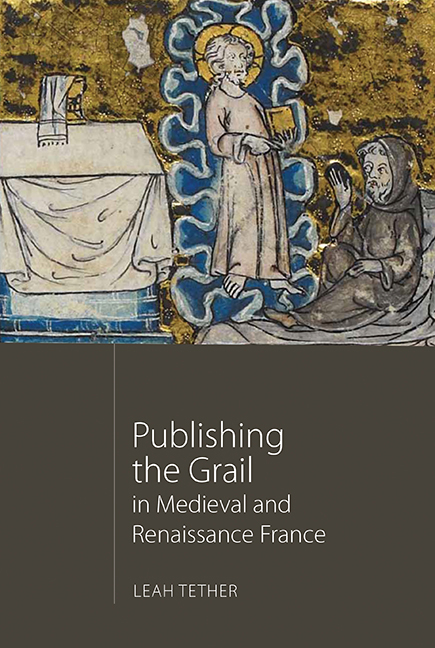Book contents
- Frontmatter
- Contents
- List of Illustrations
- Acknowledgements
- List of Abbreviations
- Miscellaneous Frontmatter
- Introduction: Grail Literature in France c. 1180–1530
- 1 Publishing in the Middle Ages and the Renaissance
- 2 Blurbing the Grail
- 3 Disclosing the Author
- 4 Re-packaging the Grail
- 5 Patronage and Promotion
- Conclusion
- Appendix: Timelines of Composition and Production
- Bibliography
- Index
- Arthurian Studies
- Frontmatter
- Contents
- List of Illustrations
- Acknowledgements
- List of Abbreviations
- Miscellaneous Frontmatter
- Introduction: Grail Literature in France c. 1180–1530
- 1 Publishing in the Middle Ages and the Renaissance
- 2 Blurbing the Grail
- 3 Disclosing the Author
- 4 Re-packaging the Grail
- 5 Patronage and Promotion
- Conclusion
- Appendix: Timelines of Composition and Production
- Bibliography
- Index
- Arthurian Studies
Summary
This chapter offers a consideration of the notion of blurbs, commencing with a discussion of blurbs in the modern context, before exploring what kinds of medieval/early-modern textual apparatus in our Grail texts can legitimately be seen as fulfilling similar functions. I investigate publishers’ strategic manipulation of these blurbs, both textually and within the mise en page, and develop conclusions as to what we might understand as having been the key marketing factors for French Grail texts, and whether such trends developed over time.
Blurbs, in the modern sense of the term, are one of the most pivotal marketing tools in convincing a customer either to engage further with the product or to purchase it. In 2010, for example, The Bookseller reported on a study by Book Marketing Limited, which had shown that ‘the blurb makes 62% of consumers buy a particular product’. The value added by the blurb, therefore, cannot be overestimated. The narrative structure, presentation and positioning of blurbs as we know them today are, of course, rather modern devices, developed to complement shifts in book production and marketing, particularly since the turn of the twentieth century. The term itself appears only to have come into use in 1907, when Gelett Burgess, an American humorist, published a book called Are You a Bromide? and was promoting it at a trade show. Burgess persuaded his publisher to produce a special dust jacket depicting a young woman calling out alongside the usual cover copy. This copy was written to sound as if the young lady was speaking out in praise of the book and it carried the title ‘YES, this is a “BLURB”!’ Additionally, the image was captioned: ‘Miss Belinda Blurb in the act of blurbing’. The term gained swiftly in popularity and soon came to be used to describe the marketing copy displayed on book covers, a device which had been in use for some time. There is, though, a certain vagueness about what kinds of cover copy might be counted as a blurb according to Burgess’ definition. Is it material written by the author, or rather publisher-authored copy? Are endorsements from other authors included? Does it matter where it is positioned (back cover or flap)?
- Type
- Chapter
- Information
- Publishing the Grail in Medieval and Renaissance France , pp. 27 - 62Publisher: Boydell & BrewerPrint publication year: 2017



